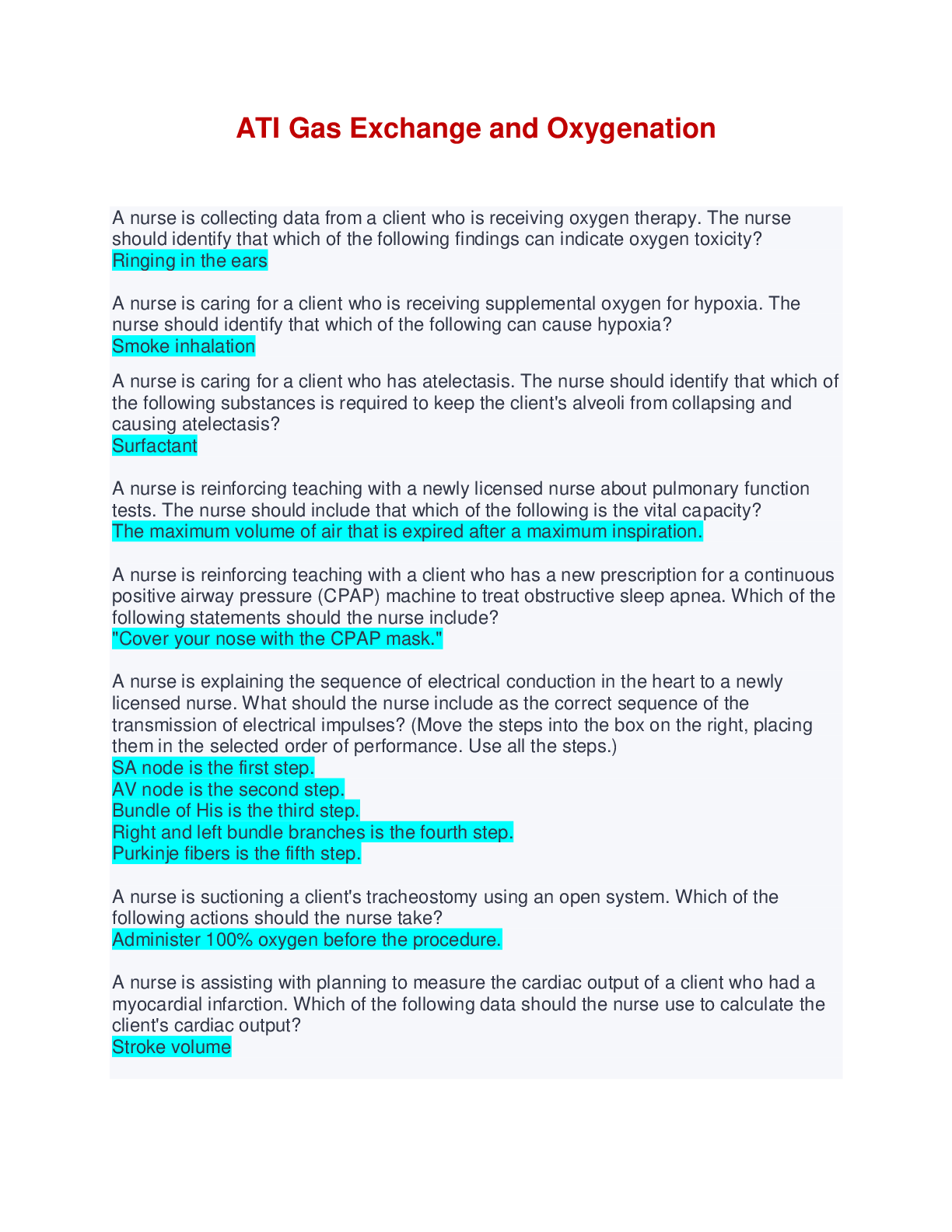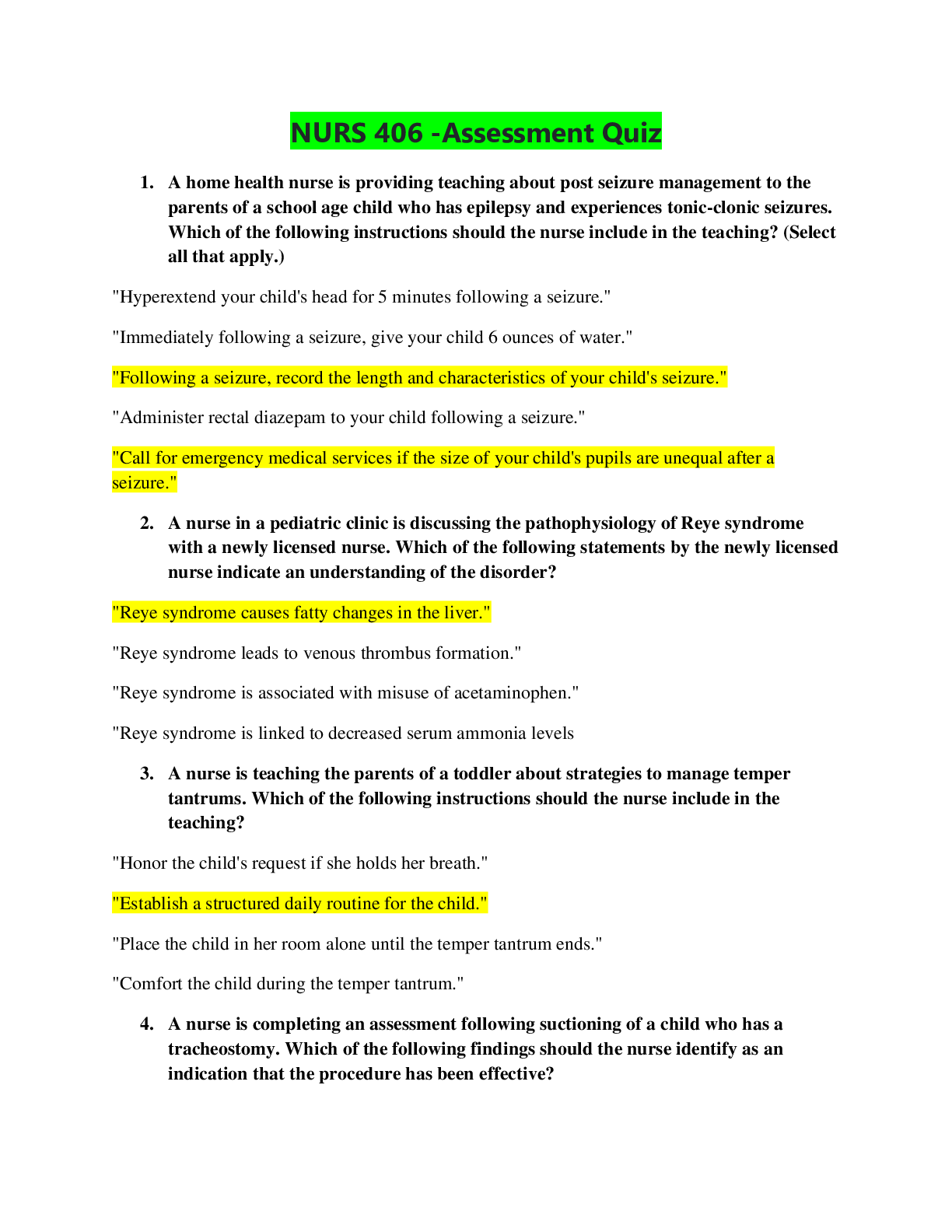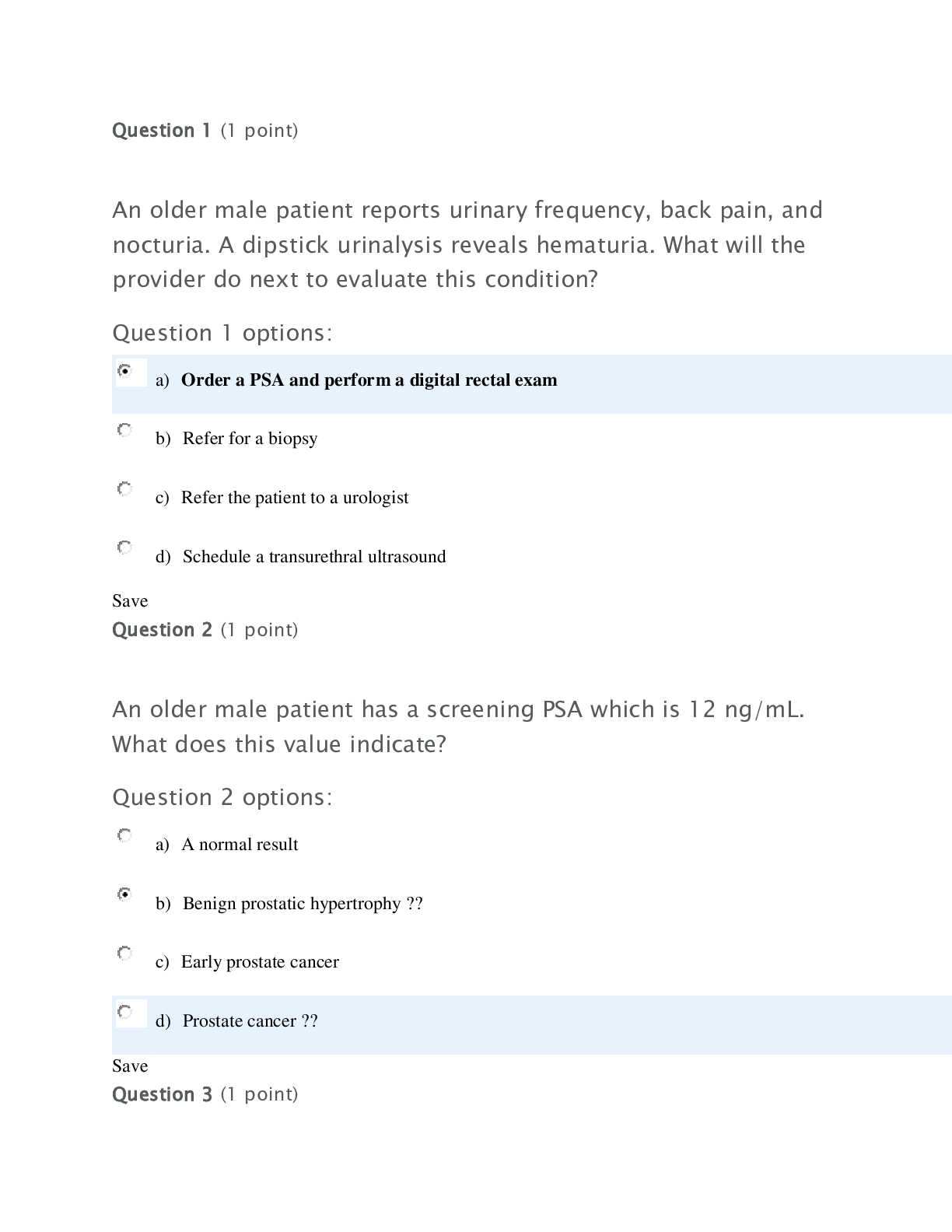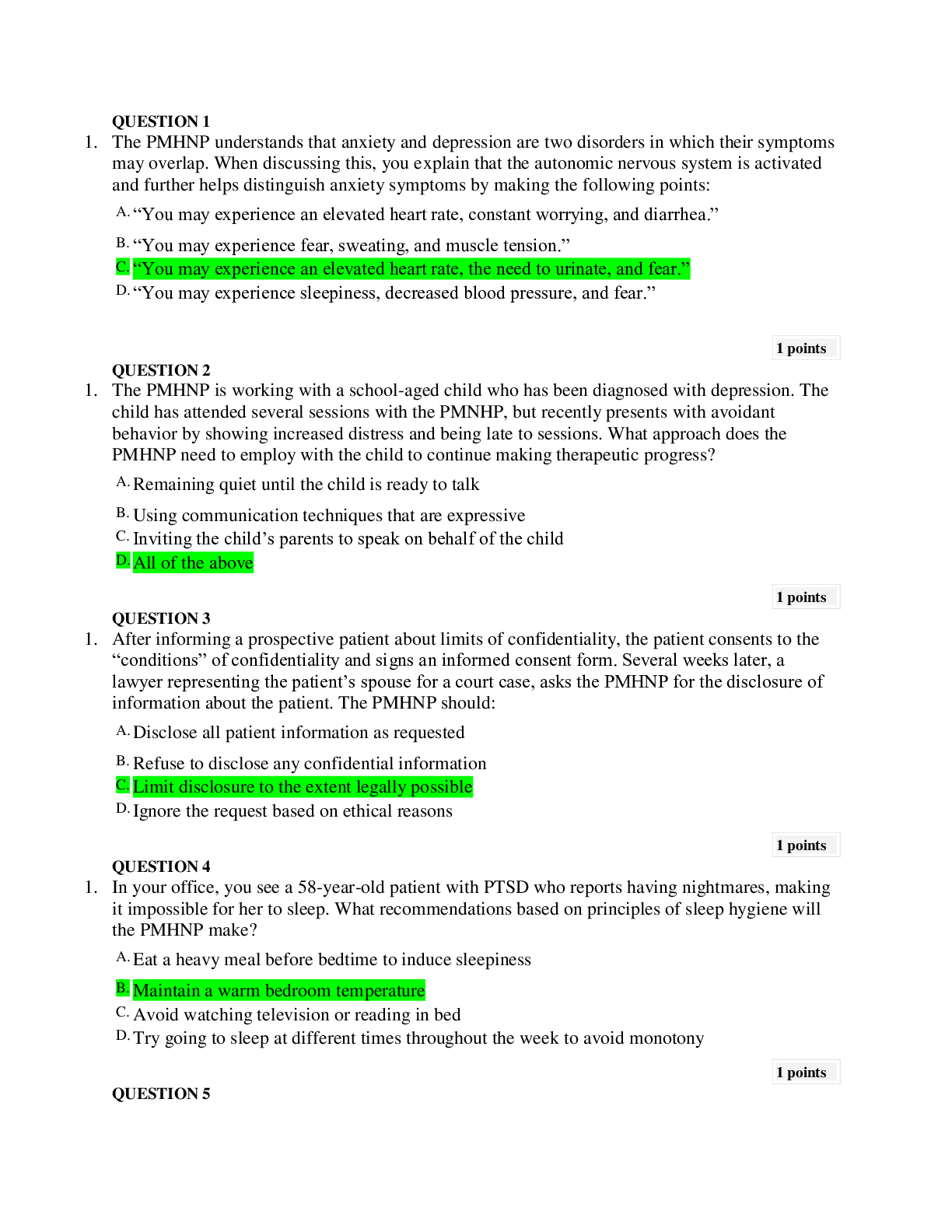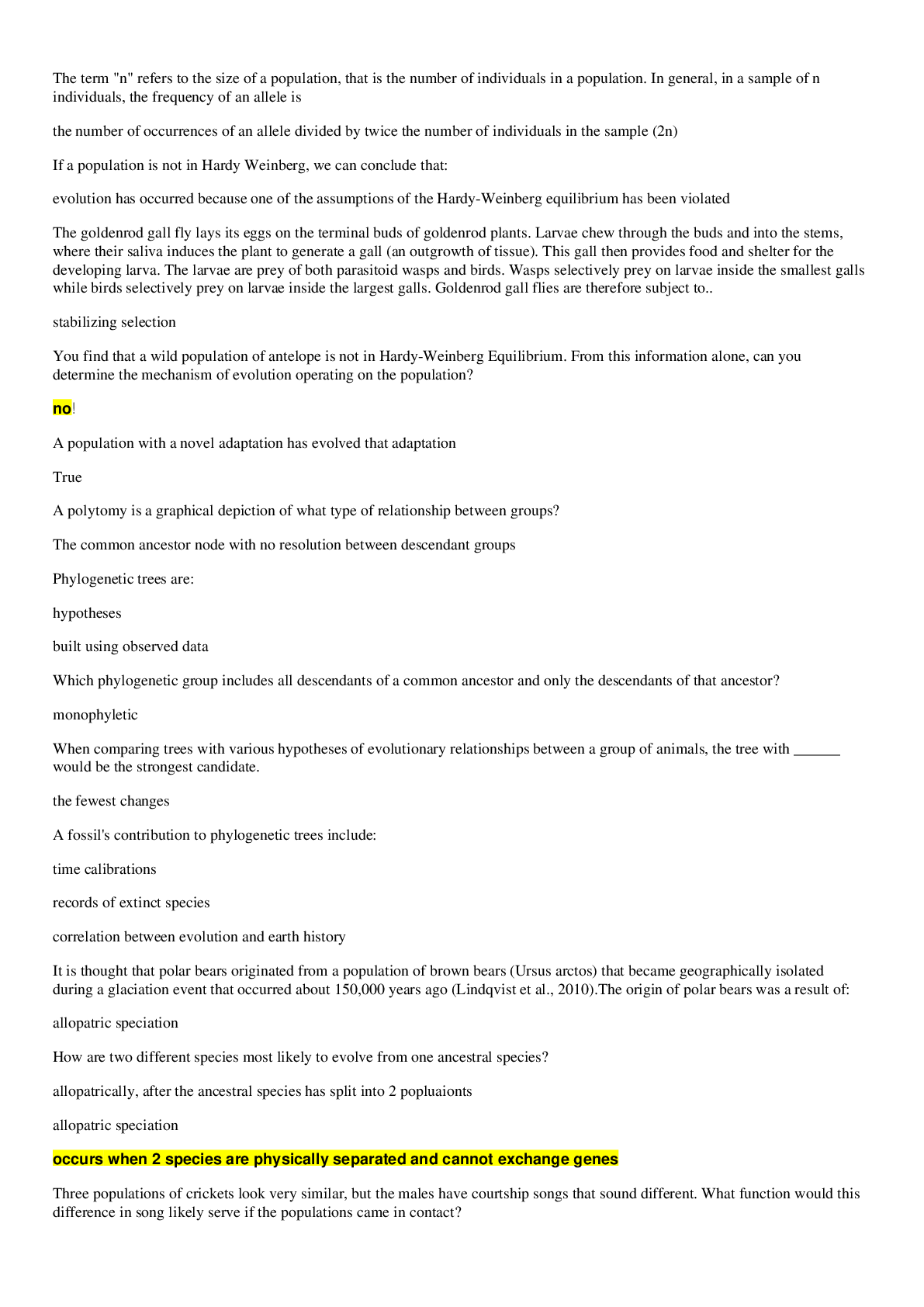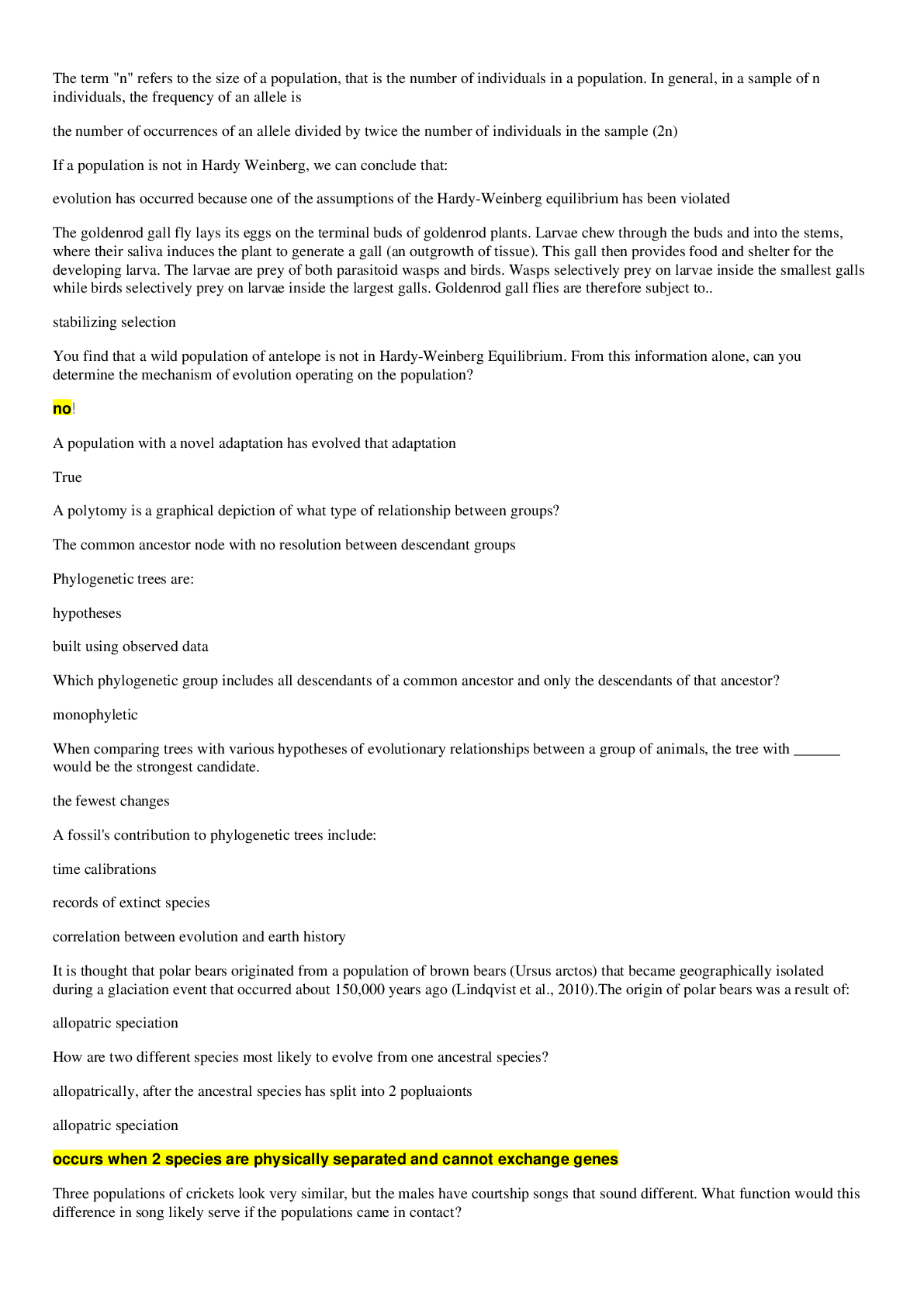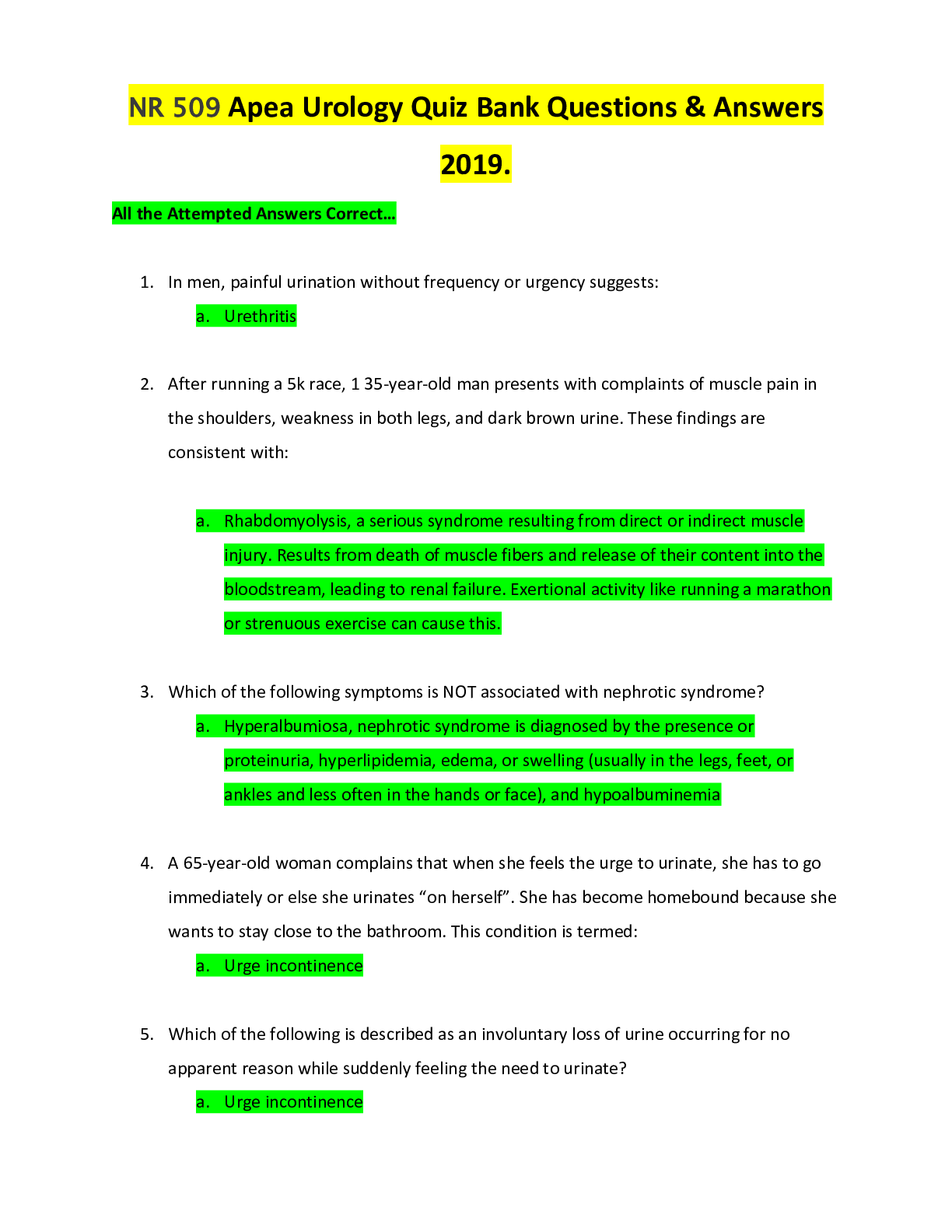*NURSING > EXAM > Chamberlain College of Nursing - HSM 544 Week 8 Final Exam Questions and Answers Rated A (All)
Chamberlain College of Nursing - HSM 544 Week 8 Final Exam Questions and Answers Rated A
Document Content and Description Below
HSM 544 Week 8 Final Exam 1. (TCO H) Ethics is defined by Pozgar as "a branch of philosophy that deals with values relating to human contact with respect to the rightness and wrongness of actions and... the goodness and badness of motives and ends." Describe two ethical dilemmas you may encounter in a healthcare setting related to patient care. In the description, define at least one law or regulation that may apply to each ethical dilemma. (Points : 35) One major ethical dilemma that may be encountered in a healthcare setting is dealing with abortion. This issue is difficult because it can restrict or demand that a professional perform a duty that they do not believe is ethical. The dilemma is caused by the conflict between personal and professional ethics. Because abortion was legalized in Roe vs. Wade in 1973 the law compels medical professionals to provide medical treatment (Pozgar, 2012). Under Row vs Wade medical professionals are limited to providing abortions to the first two trimesters. Another major ethical dilemma that may be encountered in a healthcare setting is the issue informed consent. From a legal perspective, patients who are not provided proper information concerning procedures, have the right to seek legal remedy. Under the law, the patient must provide consent and must understand what she is consenting to having performed. This should be done in writing as well as verbally in many instances (Pozgar, 2012). One of the earliest legal cases which established the concept and requirement for informed consent was Schloendorff vs. Society of New York Hospital in 1914 (Mary E. Schloendorff, Appellant, v. The Society of the New, 1914). In this landmark case a physician removed a tumor from a patient who only consented to a diagnostic procedure. The judge ruled that in this case ruled that an “individual’s fundamental right to decide what is being done with his or her body.” The physician was liable both in civil and criminal charges. Since that case, the concept of informed consent has been continuously defined and upheld by courts. References Mary E. Schloendorff, Appellant, v. The Society of the New. (1914). Mary E. Schloendorff, Appellant, v. The Society of the New. Retrieved from University of Wisconsin: https://mywebspace.wisc.edu/rstreiffer/web/CourseFolders/BioandLawF99Folder/Readings/SchloendorffvSociety_of_NY.pdf Pozgar, G. D. (2012). Legal Aspects of Healthcare Administration. Sudbury: Jones & Bartlett Learning. 2. (TCO D) A patient's family may be actively involved in end-of-life decisions for patients who are incapacitated or incompetent. Compare and contrast two legal cases that address the rights of families in participating in end-of-life decisions. For each legal case, identify how the case either contributed or detracted from the rights of families. (Points : 30) The Terri Shiavo case was a difficult ethical situation due to the fact that Terry did not have an advance directive. After being in an accident it was confirmed that Terry was in a persistent vegetative state and would most likely never recover. The decision making for Terry would normally fall to a will or advance directive. Since this was not available, the next of kin (husband and family) would become the decision makers for Terry. However, neither party was a compelling candidate for making a decision concerning Terry’s life. Michael Schiavo gave up his right to the inheritance he would have received after the death of Terri Schiavo. Although he never divorced Terri Schiavo, he had two children with another woman after Terri Schiavo was declared in a PVS. Therefore, we feel it was inappropriate that Michael Schiavo was still the legal guardian of Terri Schiavo (Lai, 2006). But Terry’s parents were not good choices for making decisions concerning Terry because The parents of Terri Schiavo had the strong conviction that Terri wanted to live. Since the parents were next of kin, they should have been the legal guardians, yet during the 15 years from 1990 to 2005, they did not provide any substantial care to their daughter nor did they give Michael Schiavo any financial help. Thus, it is difficult to understand the motives of either Michael Schiavo or the parents (Lai, 2006). This case in many ways detracted from the rights of families by allowing the hospital administration and judicial body to intervene on Terry’s behalf. This was detraction from the rights of families due to the fact that the case highlighted the problem of conflicting family opinions. The case did however, highlight the need for an advance directive which also supersedes family rights. Another case that detracted from the rights of families was the Nancy Cruzan case of 1990. In this case, Nancy Cruzan was in persistent vegetative state and her parents desired to remove her from life support (deeding tubes) in order to terminate her life. The Cruzan case was spotlighted in the media because the courts did not feel that the right to refuse medical treatment applied in this situation and without an advance directive the state had no choice but to keep Nancy Cruzan alive. Ultimately, the decision of the court would reflect that family does not have full authority in these cases. The Cruzan case inspired the PSDA because an advance directive would have solved the dilemma (Lewin, 1990). References Lai, M.-L. (2006). The Ethical Issues Raised by the Terri Schiavo Case. Retrieved from Department of Neurology, College of Medicine, National Cheng Kung University, Tainan, Taiwan: https://www.tzuchi.com.tw/file/tcmj/95-v18n5/18-5-401-403.pdf Lewin, T (1990). Nancy Cruzan Dies, Outlived by a Debate Over the Right to Die http://www.nytimes.com/1990/12/27/us/nancy-cruzan-dies-outlived-by-a-debate-over- the-right-to-die.html 3. (TCO G) Identify three medical liability classes and provide a specific example for each class. Explain how the individual or entity behaved or acted in a way that may result in legal action. (Points : 25) There are three medical professional liability classes: 1. Individuals such as doctors or nurses. These individuals may be catalysts for legal action such as in cases of malpractice or negligence. For instance, a doctor who performs a procedure without the consent of the patient can create legal action as this is considered malpractice. 2. Healthcare institutions such as hospitals or nursing homes. These institutions can behave in ways that are considered unethical and illegal such as refusing to treat people who need emergency treatment. Under the law all institutions are required to stabilize a patient otherwise they can be held accountable under the law. 3. Outpatient facilities and clinics such as Patient First or other nonemergency clinics. These facilities are also libel for malpractice and other behaviors such as invasion of or betrayal of confidence. This behavior could result from billing practices which are inadequate to protect patient information. 4. (TCOs E and F) Compare and contrast two common models for managed care organizations. For each model, identify the inherent incentives that exist for the physicians who provide care to the patients within the model. (Points : 25) Health Maintenance Organizations or HMO’s are healthcare organizations which provide managed healthcare services. The benefit of HMO’s was supposed to be lower cost of healthcare and many of these organizations are federally certified and the healthcare professionals are contracted to perform services within the guidelines of the government policies. Services would be performed at lower cost but physicians have the incentive to work within this system because they receive a steady stream of customers. Preferred provider organization or PPO is another common model for managed care. PPO's are entities through which employer health benefit plans and health insurance carriers contract to purchase health care services for covered beneficiaries from a selected network of participating providers. The participating providers agree or abide by the utilization management and other procedures implemented by the PPO and agree to accept the PPO's reimbursement structure and payment levels. In contrast with the HMO coverage, individuals with PPO coverage are permitted to use non-PPO providers, although a higher co-payment or higher deductible could be required. Due to this option, providers agree to provide health services at prearranged discounts of their regular fee-for-service fees. Under the PPO, physicians receive a larger customer base but also slightly higher capitation. 5. (TCO G) Discuss the differences between risk management and continuous quality improvement. How do the goals of each program differ? What are the similarities between the functions of each? (Points : 25) Risk management provides a means for estimating the probability that an event will occur and sets priorities and manages risks in an appropriate way. Risk management has the goal of providing a means of assessing situations and circumstances, to determine possible dangers. Once these dangers or risks are identified and assessed, management plans can be formulated to reduce these risks. For example, falls in hospitals are a problem and the risks are assessed and then procedures and plans are implemented to reduce the risk of patients falling. Risk management differs from continuous quality improvement because it identifies possible problems. Healthcare quality management is comprised of structures, processes, and outcomes. Structures are the framework of services provided to improving quality management. Processes are actions taken to evaluate the way services and care are provided. Outcomes are the good or bad results of the improvement process. These components of healthcare quality are subject to improvement which means setting standards. For example, customer service satisfaction is an area that will require constant improvement. This is not an area of risk. 6. (TCOs A and B) What do you consider the most pressing ethical issues surrounding genetic testing? Provide at least two examples, and explain why you consider these most important. (Points : 30) Genetic testing covers a broad area of topics, many of which are controversial because of ethical issues. Two of the most pressing ethical issues surrounding genetic testing include: engineering and stem cell research. These two areas of genetic research are controversial because they either involve unknown potential problems are they are problematic for religious reasons. Genetic engineering is the manipulation of an organism’s genome in order to achieve an affect. For instance, many foods are genetically engineered to be resistant to insects and disease. This allows for larger crops to be grown. Genetic engineering is controversial because many people see the practice a dangerous because there is an unknown potential for danger. For instance, genetically engineering crops to be resistant to disease may create super diseases. Stem cells are unspecialized cells capable of renewing themselves through cell division, sometimes after long periods of inactivity. Stem cells occur mainly in embryonic stages of development. Because these cells are unspecialized they can potentially be used to repair and create organs in the body. However, stem cells are highly controversial because in order to obtain them they may be taken from destroyed embryos. 7. (TCO C) Identify and discuss the four components of HIPAA. For each component, identify a violation that may occur in a healthcare setting that might lead to an investigation by the OIG. (Points : 30) The four Components of HIPAA include: Electronic Transaction and Code Set Standards- Healthcare providers are required to submit claims information using the same codes for procedures. Failure to use the proper codes can result in fines. For example, when submitting an Medicaid claim, if the wrong code is used the organization will not be paid and they will be fined. Privacy Standards- When submitting information electronically, this information must meet disclosure standards. For example, when transmitting information to a different network the patient must be informed. Security Standards- HIPPA requires that information networks meet specific security standards which are both technical and physical in nature. For example, if a nurse were to simply fax a patient’s records across an unsecured line this would result in a violation and fine from the government. National Identifier- Under HIPPA, all healthcare providers must have a standard national number to identify them within transactions. Failure to use this number on transactions will result in fines from the government. Major Tasks of Economics Q. Identify the major tasks of economics and discuss why they are important. What are their roles in organization management? Ans. The three major tasks of economics are description, explanation and evaluation. Description: is the fundamental task of economics and it includes the identification, definition and measurement of any phenomena. Through this task we can have the idea about the existing facts. This task is mostly related to facts finding. For instance, in America, in 1992 the average of 65 years older people visited physician’s office was 5.5 times each year and the average of 15 to 22 years old people was of 2.5. This statement will fall under the category of description. The process of description helps the organization in better understanding of what is happening in the company at each level that later help in improvement. Explanation: the second task of economics is of explanation and prediction of certain phenomena. In this task there is cause and effect analysis is done. An example of explanation task is that why people of 65 years older and more use more medical care than younger people. This task helps the organization on identifying causal factors so that it can analyze how much these factors are contributing to outcomes. Evaluation: the third task of economics is evaluation that focuses on analyzing and making judgment about the alternate phenomena according to some standard. First standard is chosen then it is used to rank the alternative means of distribution of resources that are scarce that leads to desired outcomes. This helps in creating a natural process and generating funds for the benefits of health care services. Source: Jacobs, P. & Rapoport, J. (2004). The Economics of Health and Medical Care. 5th ed. Canada: Jones and Bartlett Publishers. Q. Identify and discuss the factors that influence the demand, in turn healthcare economics. What factor do you believe has the greatest impact on healthcare economics and why? Ans. There are many factors that contribute in increasing the demand for healthcare. These are as follows: Age: age is a primary factor that influences the demand for health. Since, due to advances in medicine people are more likely to live longer than before. Quality of Medical Care: quality of medical care also influences its demand because if the quality of care is low then the demand will be low too. Government Policies: the Affordable Care Act required all citizens of United States to get health insurance. The implementation of this policy has increased the demand of health care irrespective of willingness of people. Income: with the rise of the household income it is expected that the demand for healthcare will also increase too. Education: when people will be more educated then they will be more aware of the hazards of smoking and drinking etc. Hence, the demand of health care increases with the increase in educated people. Uncertainty: There is uncertainty in life like anyone can become sick or any accident can happen. Due to such uncertain situations in life, people protect themselves by health care insurance that is also a financial burden over their families. Time and Cost of Medical care: Time and cost of the health care also affects the demand of it. Since, how much time a person takes in travelling to the physician also count as cost. Resource: Stano, S. G. (2010). Economics of Health and Health Care, 6th Edition p. 136-138 [VitalSource Bookshelf version]. Source: Jacobs, P. & Rapoport, J. (2004). The Economics of Health and Medical Care. 5th ed. Canada: Jones and Bartlett Publishers. Q. Discuss the role of all parties (patient, providers, and payers) to contain costs. Analyse the impact of cost-containment efforts on the rising cost of healthcare. Ans. U.S. healthcare costs per capita are the highest in the world. Patients, providers and payers can contain the cost of health care. They can contain the cost by improving the quality and efficiency of care and by using evidence based medicine. Providers: Health care service providers bear the major responsibility of reducing cost. They can reduce costs by improving the quality of medical care and by using evidence based medicine. Patients: Patients can contain the cost by increasing use of inexpensive preventive services like screening and medical tests. Patients can use strategies to increase preventive care like consulting primary care physicians and eliminating co-payments for preventive services. Payers: Payers can increase out-of-pocket costs to provide an economic incentive to the patients to limit their own health care use. They can do so by limiting the number of visits of healthcare, increasing deductibles and payments and decreasing allowed amounts for covered procedures. Q. What are the primary steps in a production function analysis? How would you apply these steps in a healthcare organization? According to economic theory, production function shows the relationship between input and output. The change in the quantity of variable input also changes the quantity of output produced. But fixed inputs do not change with the level of outputs. There is the concept of diminishing marginal return when over increase of each input unit will yield less output. In health care units like hospitals, the resources used (inputs) in a hospital depends on the purchasing of hospital and cost accounting records as contrary to charges of patients that do not reflect the resources used. http://wwwnc.cdc.gov/eid/article/7/2/70-0282_article Q. Discuss the connection between redistribution and social insurance In health care, redistribution is shifting of cost and benefits of health insurance from one group to another group. It is like transferring the buck to others and it is generally transferred from a person who is quite wealthy and passed on to less privileged people. Medicare is the largest redistribution and people who are new and eligible for it then the buck passed from the old people to the new people. This process is done by increasing the premiums for the people who are already on Medicare. On the other hand, social insurance is a set of insurance programs that are run by government. This provides benefits to the people insured and only those people are benefited from it. This program is financed by the taxpayers from payroll taxes. Q. How does the role of non-profit healthcare organizations differ from profit healthcare organizations? Ans. According to the textbook, non-profit healthcare organizations contribute to only 5% to GDP, but they are important portion of the healthcare sector. More than 60 percent of community hospitals provide services of 70%. Non-profits organizations also comprised of 30% of nursing homes and half of the patients are mental ill and substance abusive. In economic term, the largest difference of non-profit firms is the non-distribution constraint and the evidence that none has the legal claim on non-profits residual. Hence, non-profit have different purposes than the profit ones. They provide demand for public goods that private organizations or governments cannot provide. However the non-profits provide average quality of the market. Since, it is difficult to assess the quality outcomes in non-profit organizations. Sherman Folland, Allen Goodman and Miron Stano (2009). The Economics of Health and Health Care, 6th Edition, Pearson, Prentice Hall Q. Discuss the concept of managed care. Why was it created? What were its goals? Have these goals changed? Has it worked? How it can be improved? Pick one of the previous questions for your initial post; all of them will be discussed throughout the week. Ans. Managed care is the second name for the multiple healthcare payment systems. The basic purpose is to control cost by controlling different types services provided. Health maintenance organization is mostly used with managed care; the objective of managed care is to reduce cost of health care. To reduce cost the responsibilities of limiting such services will be put on the service providers rather than the consumers. There are many ethical considerations related to managed care despite it is successfully fulfilling its purpose of reducing cost in USA. There are many arguments made on the issue that changes have reduced the patient care and patients have only to choose under the plan that are limited locations. http://www.minddisorders.com/Kau-Nu/Managed-care.html [Show More]
Last updated: 1 year ago
Preview 1 out of 8 pages
Instant download
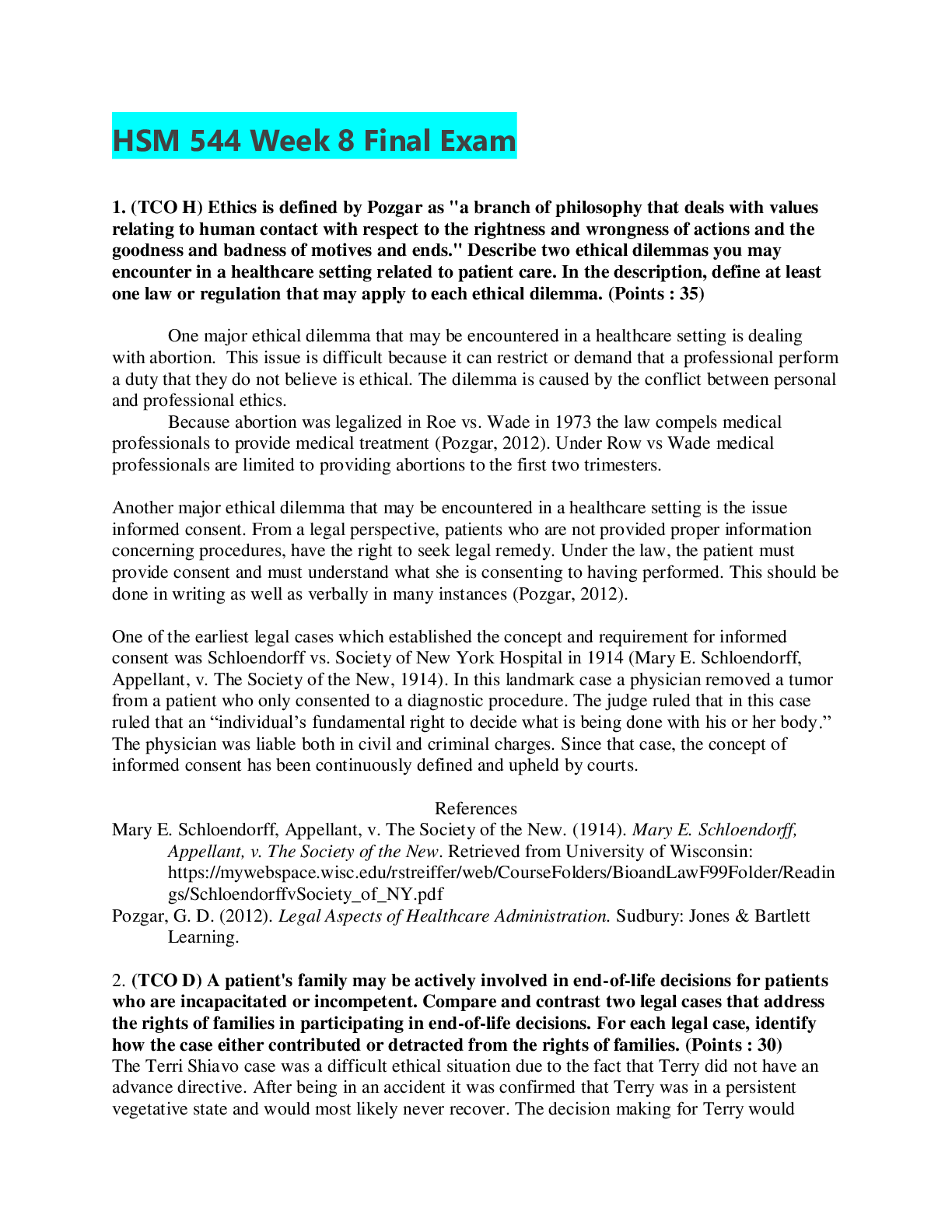
Buy this document to get the full access instantly
Instant Download Access after purchase
Add to cartInstant download
Reviews( 0 )
Document information
Connected school, study & course
About the document
Uploaded On
Nov 05, 2020
Number of pages
8
Written in
Additional information
This document has been written for:
Uploaded
Nov 05, 2020
Downloads
0
Views
101


